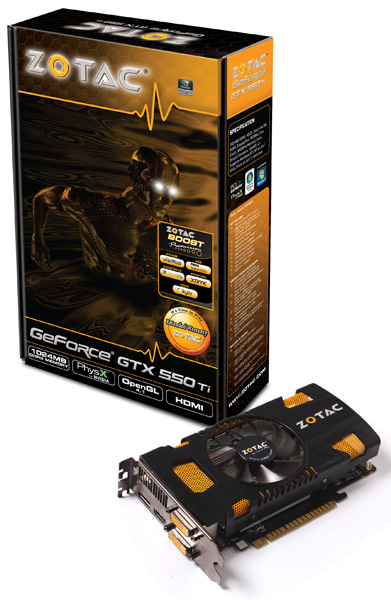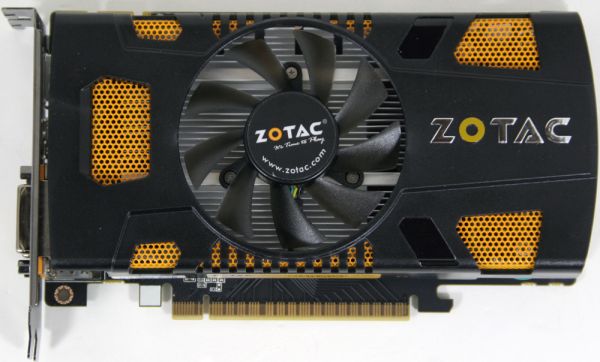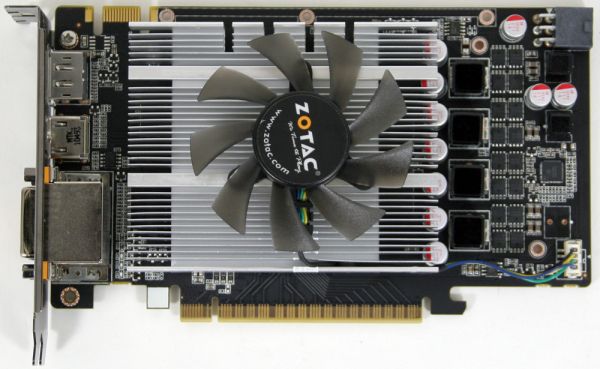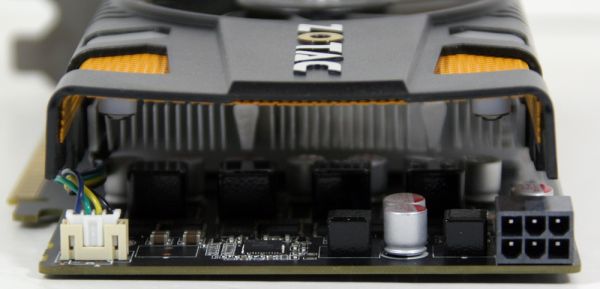NVIDIA's GeForce GTX 550 Ti: Coming Up Short At $150
by Ryan Smith on March 15, 2011 9:00 AM ESTMeet The Zotac GeForce GTX 550 Ti AMP Edition
As we stated at the start of this article, NVIDIA is not directly sampling GTX 550 Ti reference cards for this launch. Instead they have left it up to partners to do the sampling. Zotac in turn has provided us with their factory overclocked model, the GeForce GTX 550 Ti AMP, a custom design clocked at 1000MHz core and 1100MHz (4400MHz data rate) memory. We’ll be looking at performance at both stock GTX 550 and Zotac factory clocks.
The AMP is very similar in design to Zotac’s previous GTS 450 AMP card, which is not surprising given the near-perfect compatibility of the GTS 450 and GTX 550 designs. Zotac does not provide thermal/power data for their cards, but with the factory overclock we’d expect it to be a bit more than the 116W for the reference design.
At a hair under 7.5” and using a double-wide cooler design, the AMP is nearly ¾ of an inch shorter than the original GTS 450, reflecting the fact that NVIDIA’s partners often end up producing shorter cards. A simple shroud covers the card, which directs most of the airflow from the 74mm fan out the front and the rear of the card. If we remove the shroud we find a rectangular aluminum heatsink covering the GPU – the GDDR5 memory remains uncovered.
Power is supplied by a single rear-facing 6pin PCIe power socket, which provides more than enough power for a lower-power device such as the AMP. Zotac has outfitted the chip with Hynix GDDR5; 4 1Gb chips and 2 2Gb chips. All of them are rated for 5GHz operation, so even at 4.4GHz the AMP is running its memory below what the chips are capable of, not counting what the bus and GPU itself are capable of handling. Meanwhile as was the case with the GTS 450, a single SLI connector is provided for 2-way SLI.
A common theme with customized Zotac designs is support for additional display connectivity options beyond the NVIDIA reference design, and Zotac does not disappoint here. By shifting a DVI port to the 2nd slot, Zotac has outfitted the card with a full size DisplayPort, along with upgrading the HDMI port from mini to full size; they are still limited in terms of total displays by the GPU however, and even with 4 ports can only drive 2 displays at once. Zotac continues to be one of the only NVIDIA vendors we regularly see support DisplayPort, a sharp contrast from AMD & their partners who include it on virtually everything.

Rounding out the package is the usual collection of extras from Zotac. For hardware this means a molex-to-PCIe power adapter and a DVI-to-VGA adapter. Meanwhile on the software size Zotac continues to provide the Boost Premium package, which includes a collection of OEM & trial copies of various GPU-accelerated programs, including vReveal, Nero Vision, Cooliris, XBMC, and Kylo.
Zotac is pricing the card at $169 $155, $5 more than the NVIDIA MSRP for a basic card. With it comes a 2 year warranty, and a 3rd year is added upon registration.














79 Comments
View All Comments
Marlin1975 - Tuesday, March 15, 2011 - link
But over priced.If this was in the $100 area it be a much better buy. But the cheaper 460 is better right now.
Also you have the 450 in yoru graph as a 256bit bandwidth, not the 128bit it is.
vol7ron - Tuesday, March 15, 2011 - link
I'm not usually an advocate of OCing gpus, but I'm curious how much more performance could be achieved. We know there's some room in the memory, how much more can the gpu/shaders really extract? While Zotac OCs, they normally don't max it out on air cooling, so a little testing would be nice :)slickr - Tuesday, March 15, 2011 - link
Its a crap card.Its about $50 overpriced, its worse in consumption, noise and coolness than Nvidia's own 1 year old GTS 450.
So how can this be a good card? For the same price I can get a GTX 460 768mb that performs 20% faster and I can get cooler, quieter and less power draw card for $50 less in the 5770 and still get the same performance.
If you ask me this card is a rip off for consumers who don't know anything about graphic cards.
Aircraft123 - Tuesday, March 15, 2011 - link
I really don't understand why nVidia is so concerned with these lower performing cards.Their own cards from TWO GENERATIONS AGO perform better then this "new" card.
I have a GTX275 it will perform equivalent or better than this new card and you can find it on a particular auction site for ~$100.
The only thing missing from my 275, is directX 11. Which unless you get a 470 or greater the card isn't powerful enough to run any dx11 stuff anyway.
I could also say the same for AMD considering the 4870 performs better than the 5770.
I am interested in the dual fermi card due out soon though. It will be interesting if/how they can beat the 6990 with lower power sonsumption/noise.
Anyhow good article.
Marlin1975 - Tuesday, March 15, 2011 - link
The reason is the re-work I bet has a better yeild number, let alone more performance from the same chip with a new series number.So people think they are getting new cutting edge when its just a 4xx series chip re-worked.
Taft12 - Tuesday, March 15, 2011 - link
In fairness, if we are considering dollars and cents your GTX275 has a TDP twice the 550 Ti, and probably eats up double or more at idle as well.jiffylube1024 - Tuesday, March 15, 2011 - link
The GTX 275 costs a lot more to make than the Ti 550 (they couldn't mass manufacture the GTX 275 card at a $100 or even $150 pricepoint and hope to make a profit) and a GTX 275's that you could find for $100 today would either be old stock (meaning they're just clearing inventory) or a used card, meaning no profit for Nvidia whatsoever.It's pretty obvious that companies come out with these cards to occupy lower pricepoints... The problem is that, as you point out, they are often too cut-down and previous generation cards throttle them. It's a balance, and when they hit the right price/performance, magic happens (GTX 460), but they often miss the mark on other cards (GTS 450, Ti 550).
Even if you examine the Ti550 on paper, it stands no chance vs the GTX 460 -- it has 56% less shader power than the GTX 460 (336 shaders vs 192; a similar drop in texturing power) and not enough of a clockspeed advantage (900 MHz vs 675 MHz) to make up for that. At $150, the Ti550 is a total waste since you can find GTX 460's for $130 or less these days. It's going to take a fall below $100 for these cards to become worthwhile.
Nevertheless, if GTX 460 stock dries up, then without a Ti 550, Nvidia has a gaping hole below $250.
I think this has a lot to do with manufacturing costs -- it's not economical to keep making GTX 460's and sell them for ~$100. The Ti 550 has 66.7% the transitor count of the GTX 460, meaning a much cheaper die to manufacture.
Kiji - Tuesday, March 15, 2011 - link
"Indeed the GTX 550 Ti is faster than the 5770 - by around 7% - but then the 5770 costs 36% more." - I think you mean "..36% less."Good review, and it's disappointing NVidia doesn't want to change their mentality.
Kiji - Tuesday, March 15, 2011 - link
Nevermind, already fixed :)passive - Tuesday, March 15, 2011 - link
At the end of page 5 you say that the 550 is ahead of the 5770 by 50%, and at 90% of the 6850. According to your graphs, both of these are very wrong (even when using the Zotacs numbers):23.1 (550) / 19.8 (5770) = 16.6%
23.1 (550) / 29.8 (6850) = 77.5%
What's weird is that immediately after you say how the 550 is beating the 450 by 30%, which is accurate, but further paints a pro-Nvidia picture.
I know we live in era of community edited content, but in order to prevent accusations of bias, you should really catch this before you publish.